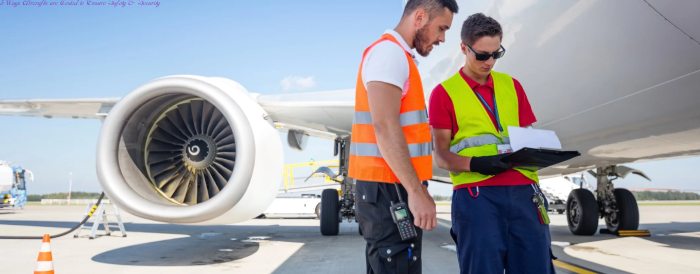5 Ways Aircrafts are Tested to Ensure Safety & Security

5 Ways Aircrafts are Tested to Ensure Safety & Security
Aircrafts, the pinnacle of modern engineering marvels, are meticulously designed and rigorously tested to ensure the highest standards of safety and security. As passengers, you board an aircraft with an implicit trust in its reliability and safety measures. However, the process that guarantees this assurance involves a series of comprehensive tests and evaluations, spanning from structural integrity to system functionality. These stringent tests are pivotal, considering the complexities of aviation and the critical role safety plays in the industry.
Table of Contents
Structural Testing
Aircraft structural testing encompasses a range of evaluations aimed at validating the strength and resilience of different components. A critical aspect of structural testing involves subjecting aircraft components to a battery of stress tests. These assessments simulate diverse operational conditions, including the aircraft’s response to heavy loads, extreme temperatures, and the rigorous forces encountered during takeoff, flight, and landing. Engineers closely monitor the materials’ reactions to these stressors, assessing how they endure and whether they exhibit any signs of fatigue, corrosion, or deformation. Such comprehensive evaluations play a pivotal role in certifying the aircraft’s structural integrity and ensuring compliance with stringent safety standards enforced by aviation regulatory bodies worldwide. Through meticulous testing, potential vulnerabilities or weaknesses in the aircraft’s design or construction can be identified and rectified, guaranteeing a safer and more robust flying experience for passengers and crew alike.
Flight Simulations
Flight simulations serve as an indispensable tool in comprehensively evaluating aircraft performance across a spectrum of scenarios and conditions. These sophisticated computer-generated simulations replicate a myriad of flight conditions, encompassing routine operations, challenging maneuvers, and simulated emergencies. By subjecting the aircraft to diverse scenarios, engineers and pilots gain invaluable insights into its behavior, performance, and response to critical situations. These simulations are instrumental in identifying and rectifying potential issues or weaknesses in the aircraft’s design, avionics, or systems, allowing for necessary adjustments and improvements to enhance safety and performance parameters. Ultimately, the meticulous examination facilitated by flight simulations plays a pivotal role in refining the aircraft’s design and systems, fostering enhanced safety, reliability, and efficiency in actual flight operations.
Wind Tunnel Testing
Wind tunnel testing is a critical phase in assessing an aircraft’s aerodynamic capabilities and behavior. It involves subjecting scaled models or components of the aircraft to controlled airflows within specialized wind tunnel facilities. By replicating various flight conditions, such as takeoff, cruising, and landing, these tests meticulously scrutinize the aircraft’s response to aerodynamic forces, including air pressure, speed, and turbulence. Engineers use the gathered data to fine-tune the aircraft’s design, aiming to minimize aerodynamic drag, enhance lift, and optimize fuel efficiency. This systematic evaluation plays a pivotal role in shaping the aircraft’s aerodynamic profile, ensuring stability, maneuverability, and overall performance during its operational lifespan. Through wind tunnel testing, engineers can precisely analyze and refine the aircraft’s design parameters, contributing to its aerodynamic efficiency and flight performance in real-world aviation scenarios.
Avionics Testing
Avionics testing constitutes a multifaceted process essential to the aviation industry’s safety and efficiency standards. Comprising intricate systems like navigation, communication, and flight control, avionics undergo meticulous evaluation to ensure their unwavering reliability and precision. Simulations and real-world scenarios are integral components of this rigorous testing regimen. These simulations replicate diverse environmental conditions and complex operational scenarios, allowing engineers to scrutinize the systems’ responses and functionalities in simulated flight environments. Through these meticulous evaluations, the goal is to guarantee that avionics systems perform seamlessly across a spectrum of situations, from routine flights to unexpected emergencies.
Furthermore, the integration of advanced tools like air data test sets into avionics testing procedures has significantly contributed to enhancing the precision and efficiency of evaluations. These test sets enable engineers to simulate and assess the performance of various sensors and instruments critical to aviation operations.
Certification and Regulatory Compliance
Before an aircraft can enter service, it must undergo certification by aviation regulatory authorities. These bodies thoroughly review design, manufacturing, and testing documentation to ensure compliance with stringent safety regulations and standards. Furthermore, these aviation regulatory authorities scrutinize every aspect of the aircraft’s design, production, and operation to ensure adherence to established safety protocols and industry-specific guidelines. The certification process involves a comprehensive examination of the aircraft’s structural integrity, systems functionality, performance capabilities, and emergency procedures. Upon successful completion of this meticulous evaluation, the aircraft is granted an airworthiness certificate, signifying its compliance with safety and operational regulations. This certification is a testament to the aircraft’s readiness to operate safely within the national or international airspace, instilling confidence in passengers, airlines, and industry stakeholders regarding its safety and reliability.
Conclusion
The commitment of the aviation industry to ensuring safety and security is exemplified by a comprehensive and meticulous evaluation process. Within this framework, aircraft manufacturers and regulatory bodies engage in extensive and in-depth analyses of structural integrity, conduct complex simulations, carry out trials for avionics systems, and maintain strict adherence to established regulations. This concerted effort aims to uphold and reinforce the highest standards of safety within air travel, prioritizing the well-being and security of passengers and industry personnel alike.
Also read :-What to Do in the Event of an Uber or Lyft Accident




